DienerPersonalitycultureandsubjectivewell-being
- 格式:pdf
- 大小:186.88 KB
- 文档页数:25
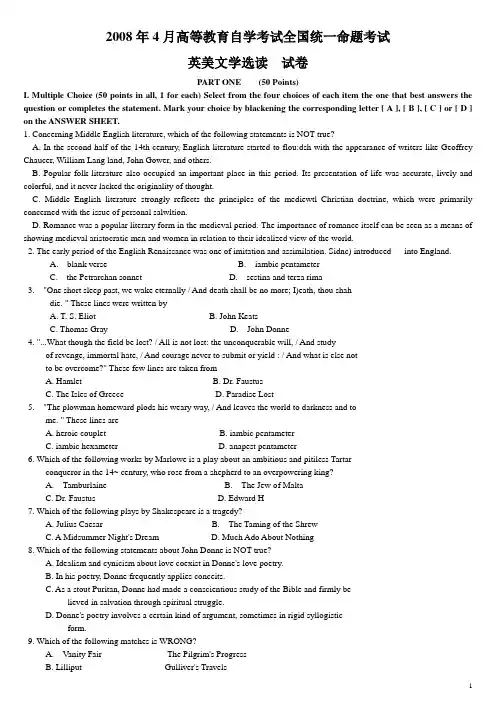
2008年4月高等教育自学考试全国统一命题考试英美文学选读试卷PART ONE (50 Points)I. Multiple Choice (50 points in all, 1 for each) Select from the four choices of each item the one that best answers the question or completes the statement. Mark your choice by blackening the corresponding letter [ A ], [ B ], [ C ] or [ D ] on the ANSWER SHEET.1. Concerning Middle English literature, which of the following statements is NOT true?A. In the second half of the 14th century, English literature started to flou:dsh with the appearance of writers like Geoffrey Chaucer, William Lang land, John Gower, and others.B. Popular folk literature also occupied an important place in this period. Its presentation of life was accurate, lively and colorful, and it never lacked the originality of thought.C. Middle English literature strongly reflects the principles of the mediewtl Christian doctrine, which were primarily concerned with the issue of personal salwltion.D. Romance was a popular literary form in the medieval period. The importance of romance itself can be seen as a means of showing medieval aristocratic men and women in relation to their idealized view of the world.2. The early period of the English Renaissance was one of imitation and assimilation. Sidnc) introduced __ into England.A. blank verseB. iambic pentameterC. the Petrarchan sonnetD. sestina and terza rima3. "One short sleep past, we wake eternally / And death shall be no more; I)eath, thou shahdie. " These lines were written by __A. T. S. EliotB. John KeatsC. Thomas GrayD. John Donne4. "...What though the field be lost? / All is not lost: the unconquerable will, / And studyof revenge, immortal hate, / And courage never to submit or yield : / And what is else notto be overcome?" These few lines are taken fromA. HamletB. Dr. FaustusC. The Isles of GreeceD. Paradise Lost5. "The plowman homeward plods his weary way, / And leaves the world to darkness and tome. " These lines areA. heroic coupletB. iambic pentameterC. iambic hexameterD. anapest pentameter6. Which of the following works by Marlowe is a play about an ambitious and pitiless Tartarconqueror in the 14~ century, who rose from a shepherd to an overpowering king?A. TamburlaineB. The Jew of MaltaC. Dr. FaustusD. Edward H7. Which of the following plays by Shakespeare is a tragedy?A. Julius CaesarB. The Taming of the ShrewC. A Midsummer Night's DreamD. Much Ado About Nothing8. Which of the following statements about John Donne is NOT true?A. Idealism and cynicism about love coexist in Donne's love poetry.B. In his poetry, Donne frequently applies conceits.C. As a stout Puritan, Donne had made a conscientious study of the Bible and firmly be-lieved in salvation through spiritual struggle.D. Donne's poetry involves a certain kind of argument, sometimes in rigid syllogisticform.9. Which of the following matches is WRONG?A. Vanity Fair The Pilgrim's ProgressB. Lilliput Gulliver's TravelsC. Thrushcross Grange Wuthering tleightsD. Thomfield Middlemarch10. The Pilgrim's Progress by John Bunyan is often said to be concerned with the search forA. material wealthB. spiritual salvationC. universal truthD. self-fulfillment11. Swift is a master satirist. Which of the following satirical works is NOT written by him?A. "A Modest Proposal"B. The Battle of BooksC. The Drapier's LettersD. "The Shortest Way with the Dissenters"12. In The Life of Jonathan Wild the Great, the word "great" is used __.A. euphemisticallyB. allegoricallyC. satiricallyD. objectively13. Which of the following statements about Samuel Johnson is NOT true?A. He was very concerned with the theme of the vanity of human wishes.B. He was rather conservative, openly showing his dislike for much of the newly risingform of literature.C. He insisted that a writer must write to please and to instruct.D. He was particularly contemptuous of moralizing and didacticism.14. All the following works were written by William Blake EXCEPTA. Songs of InnocenceB. Songs of ExperienceC. Marriage of Heaven and HellD. The Sketch Book15. "Those ungrateful drones who would / Drain your sweat -- nay, drink your blood?" Theword "drones" is used as a (n) __A. ironyB. metaphorC. metonymyD. synecdoche16. Coleridge's poems can be divided into two groups: the demonic and the conversational.Which of the following poems belongs to the conversational group?A. "Frost at Midnight"B. "The Rime of the Ancient Mariner"C. " Christabel"D. "Kubla Khan"17. One of Shelly's greatest achievements is his four-act poetic drama, Prometheus Unbound.The play is an exultant work in praise ofA. humankind's potentialB. primitive deityC. comfortable mysticismD. the primal amorality of nature itself18. The Victorian age produced a host of great prose writers, such as Thomas Carlyle, Mat-thew Arnold, John Ruskin and others. Which of the following works was written by Rus-kin?A. The French RevolutionB. History of EnglandC. Modern PaintersD. Chartism19. Charles Dickens is famous for the depiction of those horrible and grotesque characters.Which of the foUowing characters is NOT a grotesque character?A. Bill SikesB. FaginC. Mr. MicawberD. Quilp20. "What is any respectable girl brought to do but catch some rich man's fancy and get thebenefit of his money by marrying him? -- as if a marriage ceremony could make anydifference in the right or wrong of the thing! Oh! The hypocrisy of the world makes mesick!" This quotation is from __A. The School for ScandalB. The RivalsC. Mrs. Warren's ProfessionD. Widowers' Houses21. "How dull it is to pause, to make an end, / To rust unburnish'd, not to shine in use! /As tho' to breathe were life..." These lines are taken fromA. "Parting at Morning"B. "Ulysses"C. "Crossing the Bar"D. "The Lake of Innisfree"22. Which of the following statements about George Eliot is NOT true?A. She initiates a new type of realism and sets into motion a variety of developments,leading in the direction of both the naturalistic and psychological novel.B. In her works, she seeks to present the inner struggle of a soul and to reveal the mo-tives, impulses and hereditary influences which govern human action.C. She shows a particular concern for the destiny of women, especially those with greatintelligence, potential and social aspirations.D. She writes in a very narrow scope. Yet in her narrowness also lie her strong points. Itallows her to have a close study of characters and a detailed description of recurring situa- tions so that she can portray them with absolute accuracy and sureness.23. Which of the following statements about modernism is NOT true?A. Modernism is, in many aspects, a reaction against realism.B. Modernism takes the irrational philosophy and the theory of psycho-analysis as its theo-retical base.C. The modernist writers concentrate more on the private than on the public, more on thesubjective than on the objective.D. Modernist writers likeE. M. Forster, James Joyce and Virginia Woolf concentrated alltheir efforts on digging into the human consciousness.24. __ is considered to be the best-known English playwright since Shakespeare, and hisrepresentative works are plays inspired by social criticism.A. Richard SheridanB. John GalsworthyC. Oscar WildeD. Bernard Shaw25. Which of the following best describes the speaker of T. S. Eliot's " The Love Song of J.Alfred Prufroek" ?A. He is a man of action.B. He is a man of apathy.C. He is a man of inactivity.D. He is a man of passion.26. __ by D. H. Lawrence is rich in its symbolic meanings. Gerald Crich is a symbolicfigure of spiritual death. Whereas Birkin is presented as a symbolic figure of humanwarmth, standing for the spontaneous Life Force.A. The RainbowB. Women in LoveC. Sorts and LoversD. The White Peacock27. With joint efforts, some Irish playwrights brought about the Irish National Theater Move-ment in the early 20'h century, thus starting an Irish dramatic revival. All the followingwriters belong to the school EXCEPTA. Samuel BeckettB.W.B. YeatsC. Lady Gregory DI J. M. Synge28. "Come live with me and be my love, / And we will all the pleasures prove / That valleys,groves, hills, and fields, / Woods, or steepy mountain yields. " These lines were writtenby__A. Christopher MarloweB. John DonneC. Robert BrowningD. William Butler Yeats29. The desire for an escape from society and a return to nature became a permanent conven-tion of American literature. Such a desire is particularly evident in the following worksEXCEPTA. Sister CarrieB. Adventures of Huckleberry FinnC. Leather-Stocking TalesD. Walden30. "I was myself Last night, but I fen asleep on the mountain, and they've changed my gun,and everything's changed, and I'm changed" is taken from's work.A. Washington IrvingB. Herman MelvilleC. Nathaniel HawthorneD. Ralph Waldo Emerson31. The most clearly defined American literary movement in the early half of the 19th century iscalledA. ImagismB. ModernismC. NaturalismD. Transcendentalism32. Walt Whitman mourned the death of Abraham Lincoln in his famous poem called __A. "There Was a Child Went Forth"B. "Cavalry Crossing a Ford"C. "When Lilacs Last in the Dooryard Bloom'd"D. "Song of Myself"33. Which of the following is NOT a proper understanding of the symbols in the novel Moby-Dick?A. Different people on board the ship are representations of different ideas and differentsocial and ethnic groups.B. The white whale, Moby Dick, symbolizes the beautiful nature for the character Ahab.C. Moby Dick represents an ultimate mystery of the universe for the author.D. The whaling voyage is a symbolic one of the mind in quest of the truth and knowledgeof the universe.34. Mark Twain referred tb the post-Civil War era asA. "The Jazz Age"B. "The Gilded Age"C. "The Lost Generation"D. "The Beat Generation"35. The line" 'All right, then, I'll go to hell' -- and tore it up" is taken from __'s work.A. Mark TwainB. Henry JamesC. Theodore DreiserD. Emily Dickinson36. Which of the following is a distinctively Ame~can protagonist established in the RealisticPeriod?A. the noble savageB. the frontier manC. the vernacular heroD. the alienated youth37. Which of the following authors is NOT a local colorist?A. Sarah Orne JewettB. Mark TwainC. Hamlin GarlandD. Henry James38. Which of the following statements about Henry James is NOT true?A. He is famous for the international theme.B. His literary criticism is an indispensable part of his contribution to literature.C. One of his literary innovations is his use of "point of view. "D. His language is highly colloquial.39. George Hurstweod is a failed character in Theodore Dreiser's __A. Sister CarrieB. The FinancierC. The GeniusD. An American Tragedy40. Sigrnund Freud, whose ideas had great impact on the Modem Period, was famous for histheory onA. "stream-of-consciousness"B. "unconscious"C. "collective unconscious"D. "archetypal symbol"41. The following poets all belong to the Modem Period EXCEPT __A. Emily DickinsonB. Ezra PoundC. William Carlos WilliamsD. Wallace Stevens42. The lines "The woods are lovely, dark and deep,/But I have promises to keep" is takenfrom a poem by_A. Ezra PoundB. Robert FrostC. Emily DickinsonD. Walt Whitman43. Which of the following works can be read as a record of the dispossessed and the wretchedfarmers during the Great Depression?A. BabbitB. The Great GatsbyC. Winesburg, OhioD. The Grapes of Wrath44. "By seven o'clock the orchestra has arrived, no thin five-piece affair, but a whole pitful o-boes and trombones and saxophones and viols and cornets and piccolos, and low and high drums...The bar is in full swing, and floating rounds of cocktails permeate the garden out- side, until the air is alive with chatter and laughter, and casual innuendo and introduc-tions forgotten on the spot, and enthusiastic meetings between women who never knew each other's names. " The above quotation is a reflection ofA. the southern society before the Civil WarB. the middle class society in the Gilded AgeC. the affluent society after the Second World WarD. the upper class society in the Jazz Age45. In The Great Gatsby, the romantic hero Gatsby was killed in the end by __A. his rival Tom BuchananB. his lover DaisyC. Tom's mistress MyrtleD. Myrtle's husband, Mr. Wilson46. Nick Adams is the first Hemingway hero in his work entitledA. In Our TimeB. The Sun Also RisesC. A Farewell to ArmsD. For Whom the Bell Tolls47. All the following American writers have received Nobel Prize EXCEPTA. Eugene O'NeillB.F. Scott FitzgeraldC. Ernest HemingwayD. William Faulkner48. Which of the following writers had affinity to Chinese literature?A. Ezra PoundB. Robert Lee FrostC. Ernest HemingwayD. Mark Twain49. Which of the following is NOT a characteristic of WiUiam Faulkner's works?A. The breaking up of the chronological time.B. The use of multiple points of view.C. The use of simple and concise language.D. The use of symbolism and mythological and biblical allusions.50. "When Miss Emily Grierson died, our whole town went to her funeral: the men through asort of respectful affection for a fallen monument, the women mostly out of curiosity to see the inside of her house. " The above sentence is taken from 's work.A. Mark TwainB.F. Scott FitzgeraldC. Ernest HemingwayD. William FaulknerPART TWO ( 50 Points)H. Questions and Answers (30 points in all, 6 for each)Give brief answers to each of the following questions inEnglish. Write your answers in the corresponding spaceon the TEST PAPER.51. I consulted several things in my situation which I found would be proper for me: 1st,health and fresh water I just now mentioned; 2ndly, shelter from the heat of the sun;3rdly, security from ravenous creatures, whether men or beasts; 4thly, a view to the sea,that if God sent any ship in sight, I might not lose any advantage for my deliverance, ofwhich I was not willing to banish all my expectation yet.QuestionsA. Identify the author and the work.B. Who does "I" refer to7C. What idea does the above quoted express752. North Richmond Street, being blind, was a quiet street except at the hour when the Chris-tian Brothers' School set the boys free. An uninhabited house of two storeys stood at theblind end, detached from its neighbours in a square ground. The other houses of thestreet, conscious of decent lives within them, gazed at one another with brown imperturble faces.QuestionsA. The above quotation is from Joyce's "Araby". What is the torte of the narrator in thequoted passage?B. What idea does the above quoted express.'?53. Some to conceit alone their taste confine,And glittering thoughts struck out at every line;Pleased with a work where nothing's just or fit,One glaring chaos and wild heap of wit.Poets, like painters, thus unskilled to traceThe naked nature and the living grace,With gold and jewels cover every part,And hide with ornaments their want of art.QuestionsA. Identify the poet and the poem.B. What does "conceit" mean, and what does "want of art" mean?C. What is the main idea of the quoted lines?54. It seemed as if he thought a while, for now he arose and turned the gas out, standingcalmly in the blackness, hidden from view. After a few moments, in which he reviewednothing, but merely hesitated, he turned the gas on again, but applied no match. Eventhen he stood there, hidden wholly in that kindness which is night, while the uprisingfumes filled the room. When the odor reached his nostrils, he quit his attitude and fumbled for the bed."What's the use?" he said, weakly, as he stretched himself to rest.QuestionsA. The above passage is taken from Theodore Dreiser's Sister Carrie. Who does this manrefer to? What is he actually doing and why?B. Why is this novel a representative work of literary naturalism?55. "L o! There ye stand, my children," said the figure, in a deep and solemn tone, almostsad, with its despairing awfulness, as if his once angelic nature could yet mourn for ourmiserable race. "Depending upon one another's hearts, ye had still hoped, that virtuewere not all a dream. Now are ye undeceived! Evil is the nature of mankind. Evil must be your happiness, Welcome, again, my children, to the communion of your race !"QuestionsA. Identify the author and the title of the work.B. Who is the figure? Whom is he speaking to?C. What is the major theme of this work and what kind of vision of life does it reflect? HI. Topic Discussion (20 points in all, 10 for each)Write no less than 150 words on each of the followingtopics in English in the corresponding space on the TESTPAPER.56. How is Romanticism different from Neoclassicism? Provide brief evidence from the literaryworks you know best.57. Use examples to explain how Mark Twain and Henry James, both great novelists in the Re-alistic Period, are different in terms 0f their thematic concerns, characterization and stylis- tic features.。
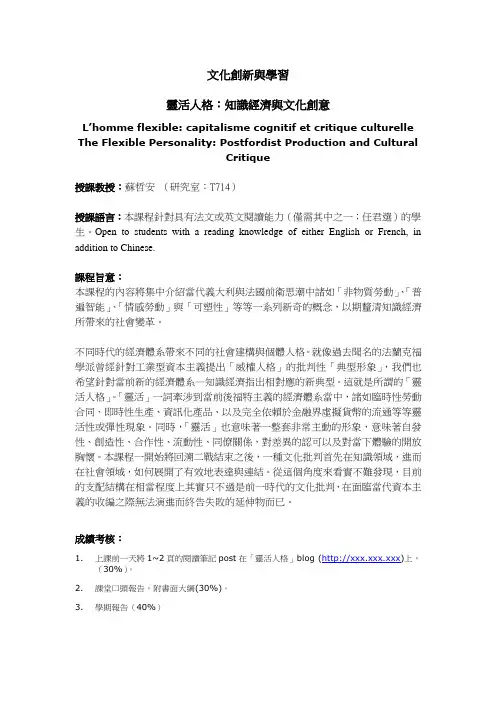
文化創新與學習靈活人格:知識經濟與文化創意L’homme flexible: capitalisme cognitif et critique culturelle The Flexible Personality: Postfordist Production and CulturalCritique授課教授:蘇哲安(研究室:T714)授課語言:本課程針對具有法文或英文閱讀能力(僅需其中之一;任君選)的學生。
Open to students with a reading knowledge of either English or French, in addition to Chinese.課程旨意:本課程的內容將集中介紹當代義大利與法國前衛思潮中諸如「非物質勞動」、「普遍智能」、「情感勞動」與「可塑性」等等一系列新奇的概念,以期釐清知識經濟所帶來的社會變革。
不同時代的經濟體系帶來不同的社會建構與個體人格。
就像過去聞名的法蘭克福學派曾經針對工業型資本主義提出「威權人格」的批判性「典型形象」,我們也希望針對當前新的經濟體系—知識經濟指出相對應的新典型。
這就是所謂的「靈活人格」。
「靈活」一詞牽涉到當前後福特主義的經濟體系當中,諸如臨時性勞動合同、即時性生產、資訊化產品、以及完全依賴於金融界虛擬貨幣的流通等等靈活性或彈性現象。
同時,「靈活」也意味著一整套非常主動的形象,意味著自發性、創造性、合作性、流動性、同僚關係,對差異的認可以及對當下體驗的開放胸懷。
本課程一開始將回溯二戰結束之後,一種文化批判首先在知識領域,進而在社會領域,如何展開了有效地表達與連結。
從這個角度來看實不難發現,目前的支配結構在相當程度上其實只不過是前一時代的文化批判,在面臨當代資本主義的收編之際無法演進而終告失敗的延伸物而已。
成績考核:1.上課前一天將1~2頁的閱讀筆記post在「靈活人格」blog (http://xxx.xxx.xxx)上,(30%)。
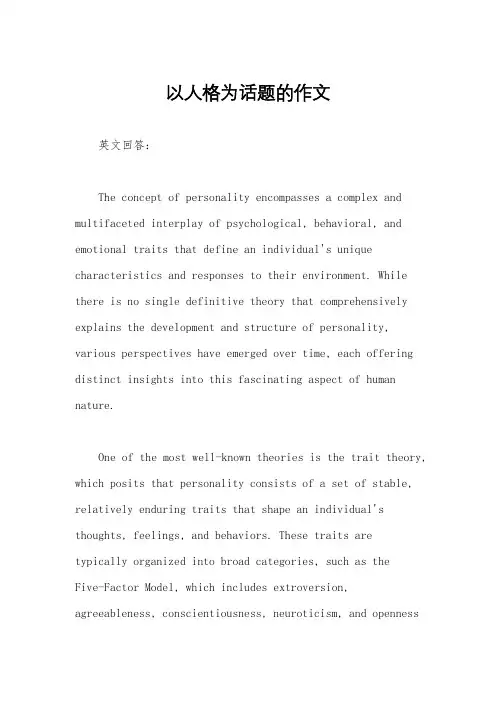
以人格为话题的作文英文回答:The concept of personality encompasses a complex and multifaceted interplay of psychological, behavioral, and emotional traits that define an individual's unique characteristics and responses to their environment. While there is no single definitive theory that comprehensively explains the development and structure of personality, various perspectives have emerged over time, each offering distinct insights into this fascinating aspect of human nature.One of the most well-known theories is the trait theory, which posits that personality consists of a set of stable, relatively enduring traits that shape an individual's thoughts, feelings, and behaviors. These traits aretypically organized into broad categories, such as theFive-Factor Model, which includes extroversion, agreeableness, conscientiousness, neuroticism, and opennessto experience.Another prominent theory is the psychodynamic theory, which emphasizes the role of unconscious processes, particularly childhood experiences, in shaping personality. According to this perspective, personality is driven by the interplay between the id, ego, and superego, with conflicts and unresolved issues from the past influencing anindividual's present functioning.Social cognitive theory takes a different approach by focusing on the influence of social and cultural factors on personality development. This theory suggests that individuals learn and adopt personality traits through interactions with others, observing and imitating behaviors that are rewarded or reinforced within their social context.Humanistic theories, such as Maslow's hierarchy ofneeds and Rogers' self-actualization theory, emphasize the importance of personal growth and self-fulfillment in the formation of a healthy personality. These theories view individuals as inherently good and capable of achievingtheir full potential when their basic needs and psychological growth are met.Each of these theories offers valuable insights into the complexities of personality, highlighting different aspects that contribute to an individual's unique characteristics and experiences. However, it is important to note that no single theory provides a complete and exhaustive explanation, and the field of personality psychology continues to evolve, with new perspectives and research不斷 emerging to deepen our understanding of this fascinating aspect of human nature.中文回答:人格是个体特有的心理特征、行为方式和情感反应的复杂而多方面的相互作用。
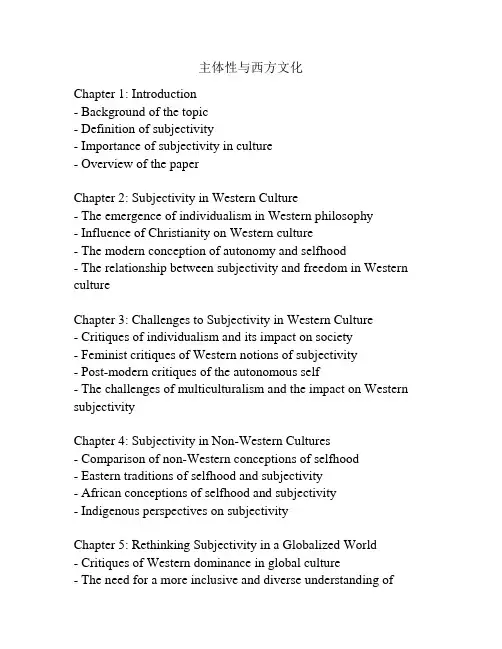
主体性与西方文化Chapter 1: Introduction- Background of the topic- Definition of subjectivity- Importance of subjectivity in culture- Overview of the paperChapter 2: Subjectivity in Western Culture- The emergence of individualism in Western philosophy- Influence of Christianity on Western culture- The modern conception of autonomy and selfhood- The relationship between subjectivity and freedom in Western cultureChapter 3: Challenges to Subjectivity in Western Culture- Critiques of individualism and its impact on society- Feminist critiques of Western notions of subjectivity- Post-modern critiques of the autonomous self- The challenges of multiculturalism and the impact on Western subjectivityChapter 4: Subjectivity in Non-Western Cultures- Comparison of non-Western conceptions of selfhood- Eastern traditions of selfhood and subjectivity- African conceptions of selfhood and subjectivity- Indigenous perspectives on subjectivityChapter 5: Rethinking Subjectivity in a Globalized World- Critiques of Western dominance in global culture- The need for a more inclusive and diverse understanding ofsubjectivity- The role of post-colonial theory in rethinking subjectivity- Implications for education and social policyChapter 6: Conclusion- Recap of key arguments- Implications for understanding and engaging with cultural diversity- Future directions for research on subjectivity and culture.第一章:引言主题背景:主观性(subjectivity)是人类认知和体验的重要组成部分。
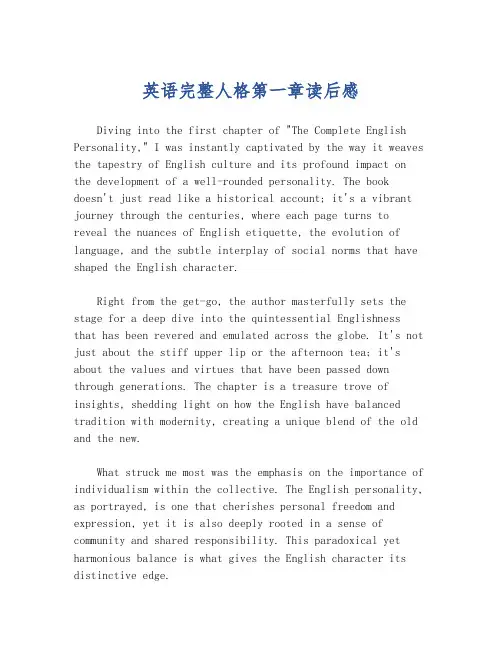
英语完整人格第一章读后感Diving into the first chapter of "The Complete English Personality," I was instantly captivated by the way it weaves the tapestry of English culture and its profound impact on the development of a well-rounded personality. The book doesn't just read like a historical account; it's a vibrant journey through the centuries, where each page turns to reveal the nuances of English etiquette, the evolution of language, and the subtle interplay of social norms that have shaped the English character.Right from the get-go, the author masterfully sets the stage for a deep dive into the quintessential Englishnessthat has been revered and emulated across the globe. It's not just about the stiff upper lip or the afternoon tea; it's about the values and virtues that have been passed down through generations. The chapter is a treasure trove of insights, shedding light on how the English have balanced tradition with modernity, creating a unique blend of the old and the new.What struck me most was the emphasis on the importance of individualism within the collective. The English personality, as portrayed, is one that cherishes personal freedom and expression, yet it is also deeply rooted in a sense of community and shared responsibility. This paradoxical yet harmonious balance is what gives the English character its distinctive edge.The narrative flows effortlessly, taking the reader through the historical milestones that have contributed to the English identity. From the influence of the monarchy to the impact of the Industrial Revolution, each era has left its indelible mark, shaping the English into who they are today.As I closed the chapter, I was left with a profound appreciation for the complexity and depth of the English personality. It's a character that is as multifaceted as it is enduring, a testament to the resilience and adaptability of a people who have weathered the storms of time. This book is not just a read; it's an experience, an invitation to understand and appreciate the essence of what it truly means to be English.。

《人是媒介的尺度——保罗·莱文森媒介思想研究》篇一一、引言在当今信息爆炸的时代,媒介的多样性和复杂性使得人们对于信息的获取、传播和交流方式发生了巨大的变化。
保罗·莱文森作为媒介环境学的重要学者,其媒介思想具有深远的影响力。
本文旨在研究莱文森的媒介思想,特别是其关于“人是媒介的尺度”这一核心观点的深入探讨,以期为理解媒介与人的关系提供新的视角。
二、保罗·莱文森的媒介思想概述保罗·莱文森的媒介思想以人本主义为核心,强调人在媒介发展中的主体地位。
他认为,媒介的发展应当以人的需求为出发点,人的需求是媒介发展的原动力。
同时,莱文森还提出了“媒介补偿性”理论,即媒介在满足人的需求时,会以某种方式补偿人的某些功能或心理需求。
三、“人是媒介的尺度”的核心观点“人是媒介的尺度”是莱文森媒介思想中的核心观点。
这一观点强调了人在媒介发展中的主体地位和作用。
首先,人作为媒介的使用者,其需求和偏好是媒介发展的原动力。
其次,人在使用媒介的过程中,不断地对媒介进行创新和改造,推动着媒介的发展。
最后,媒介的发展应当以人的全面发展为目标,为人的生活提供更好的服务和支持。
四、深入探讨“人是媒介的尺度”(一)人的需求与媒介发展莱文森认为,人的需求是媒介发展的原动力。
随着社会的发展和人的需求的变化,媒介也在不断地发展和创新。
例如,随着人们对信息获取速度和便捷性的需求增加,互联网和移动互联网等新兴媒介应运而生。
这些媒介不仅满足了人们的需求,还推动了社会的进步和发展。
(二)人的创新与改造人在使用媒介的过程中,不仅享受着媒介带来的便利和乐趣,还不断地对媒介进行创新和改造。
这种创新和改造往往源于人的需求和想象力的发挥。
例如,人们在社交媒体上创造出了各种各样的表达方式和交流方式,推动了社交媒体的多样性和丰富性。
(三)媒介的目的是人的全面发展莱文森认为,媒介的发展应当以人的全面发展为目标。
这意味着,媒介不仅要满足人们的基本需求,还要为人们的文化、教育、娱乐等方面提供更好的服务和支持。

《当代国际口译研究视域下的巴黎释意学派口译理论》篇一一、引言随着全球化进程的加速,国际口译领域逐渐受到越来越多的关注。
在当代国际口译研究中,巴黎释意学派口译理论占据着举足轻重的地位。
本文旨在全面介绍并深入探讨该理论的理论体系、特点及贡献,以进一步推进口译实践的探索与研究。
二、巴黎释意学派口译理论的背景巴黎释意学派(又称法国释意学派)的口译理论研究是当代国际口译领域中极具影响力的流派之一。
其形成和发展离不开20世纪中期至21世纪初的社会、文化与政治环境背景,特别是在经济全球化和多语种交际的需求背景下得到了发展。
三、巴黎释意学派口译理论的核心观点巴黎释意学派口译理论的核心观点在于“释意”二字。
该理论认为,口译不仅仅是语言的转换,更是对源语信息的解释和再表达。
在口译过程中,译者需在理解源语信息的基础上,运用自身的语言知识和文化背景知识,将信息准确、流畅地传达给目标语听众。
这一过程涉及到了释意、语言转换和文化交流等多个方面。
四、巴黎释意学派口译理论的特点巴黎释意学派口译理论具有以下特点:1. 注重认知过程:该理论强调在口译过程中,译者的认知活动至关重要,包括理解、记忆、分析、判断等。
2. 强调语言与文化的结合:该理论认为语言是文化的载体,口译不仅是语言的转换,更是文化的交流。
因此,译者需具备跨文化交际能力。
3. 重视实践与实证:该理论强调理论与实践相结合,通过实证研究来验证和完善口译理论。
4. 强调即席翻译:该理论认为即席翻译最能体现口译的特点和要求,因此,译者需具备高度的应变能力和快速反应能力。
五、巴黎释意学派口译理论的贡献与影响巴黎释意学派口译理论为国际口译领域的发展做出了重要贡献:1. 推动了口译研究的跨学科发展:该理论不仅涉及语言学、翻译学等领域,还涉及心理学、认知科学等多个学科,为跨学科研究提供了新的思路和方法。
2. 促进了口译教育的发展:该理论为口译教育提供了新的教学理念和教学方法,推动了口译教育的专业化、系统化和规范化。

家庭经济收入对大学生主观幸福感的影响严标宾,郑 雪,邱 林(华南师范大学,广东广州510631)中图分类号:R395.6 文献标识码:A 文章编号:1005-3611(2002)02-0118-02 Family Income on College Students'Su bjective W ell-beingYan Biao-bin,Zheng Xue,Qiu LiPs y chology Department of South China Normal University,Guangzhou510631,China【A bstract】 Objective:To explore effects of family income on subjective well-being of college students.Methods:200college students in Guangzhou completed the International College Survey Questionnaire.Results:1)Family income was correlated with life satisfaction,subjective well-being and negative emotions.2)Subjective well-being was mainly determined by pos itive emo-tions,negative emotions and life satisfaction but not economic income.Conclusion:Family income has s ome effect on subjective well-being of college students.【Key words】 Subject well-being;Life satisfaction;Emotional experience 主观幸福感个人的一种内心体验和主观评价[1]。
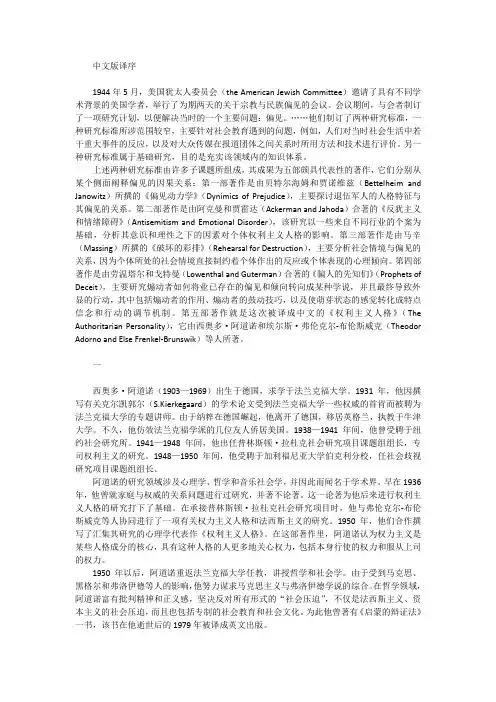
中文版译序1944年5月,美国犹太人委员会(the American Jewish Committee)邀请了具有不同学术背景的美国学者,举行了为期两天的关于宗教与民族偏见的会议。
会议期间,与会者制订了一项研究计划,以便解决当时的一个主要问题:偏见。
……他们制订了两种研究标准,一种研究标准所涉范围较窄,主要针对社会教育遇到的问题,例如,人们对当时社会生活中若干重大事件的反应,以及对大众传媒在报道团体之间关系时所用方法和技术进行评价。
另一种研究标准属于基础研究,目的是充实该领域内的知识体系。
上述两种研究标准由许多子课题所组成,其成果为五部颇具代表性的著作,它们分别从某个侧面阐释偏见的因果关系:第一部著作是由贝特尔海姆和贾诺维兹(Bettelheim and Janowitz)所撰的《偏见动力学》(Dynimics of Prejudice),主要探讨退伍军人的人格特征与其偏见的关系。
第二部著作是由阿克曼和贾霍达(Ackerman and Jahoda)合著的《反犹主义和情绪障碍》(Antisemitism and Emotional Disorder),该研究以一些来自不同行业的个案为基础,分析其意识和理性之下的因素对个体权利主义人格的影响。
第三部著作是由马辛(Massing)所撰的《破坏的彩排》(Rehearsal for Destruction),主要分析社会情境与偏见的关系,因为个体所处的社会情境直接制约着个体作出的反应或个体表现的心理倾向。
第四部著作是由劳温塔尔和戈特曼(Lowenthal and Guterman)合著的《骗人的先知们》(Prophets of Deceit),主要研究煽动者如何将业已存在的偏见和倾向转向成某种学说,并且最终导致外显的行动,其中包括煽动者的作用、煽动者的鼓动技巧,以及使萌芽状态的感觉转化成特点信念和行动的调节机制。
第五部著作就是这次被译成中文的《权利主义人格》(The Authoritarian Personality),它由西奥多·阿道诺和埃尔斯·弗伦克尔-布伦斯威克(Theodor Adorno and Else Frenkel-Brunswik)等人所著。

试析《一个青年艺术家的画像》语言变异及翻译摘要:詹姆斯·乔伊斯是20世纪英语文学史上最伟大的作家之一,作为小说艺术的革新者,他的意识流思想对全世界产生了巨大的影响,扩展了西方小说的表现力。
乔伊斯创作的自传性小说《一个青年艺术家的画像》充分展示了意识流作风的美感,而其中的各种形式的语言变异现象是对语言中现行规则系统的偏离和违反,因此,译者必须运用合理的方法将这种具有文学审美的语言变异在译文中再现,才能充分在读者面前体现其小说音乐化、诗化倾向,以更好地表现乔伊斯风格和小说情感。
关键词:语言变异翻译意识流思想自传性小说中图分类号:i106.4 文献标识码:a詹姆斯·乔伊斯是20世纪英语文学史上最伟大的作家之一,其小说创作中的意识流思想对文学界具有很大影响。
其创作的自传性小说《一个青年艺术家的画像》以主人公斯蒂芬·迪德勒斯的心理矛盾和精神感受为基本内容,带有明显的意识流语言特征和诗性美感,表现了主人公内心与各种社会势力的冲突,充满了语言变异之美,但却给翻译造成了一定的困难。
本文将讨论如何将原著的语言变异进行翻译再现,突显其优美的意识流特点,并让其艺术表现力得到最小程度的消损。
一语音和书写形式的变异和译文再现语言变异是指对语言中现行规则系统的偏离和违反,创造性地运用语言。
语言变异的目的是用于感情的强调,变平常为不平常,通过这种形式更好地显示作者内心思想,突出小说的艺术表现力,在译文中必须领悟出这种思想才能达到预期的艺术效果。
1 相似的语音变异和在译文中的再现从整体上看,小说《一个青年艺术家的画像》具备悠扬、清净的语音特征,呈现出一种淡淡的忧伤和怀旧色彩。
小说采用了清辅音组词造句,这种清楚的清辅音使得叙述轻松自然,让读者在听觉上感到不紧张。
作家特别在声音上追求产生特殊效果的词语,如头韵、词尾相似等,令小说读来产生诗歌般的音乐美感。
头韵在小说中被使用得非常多,即在一行诗或一个句子中,作家利用相邻词元音或辅音发音相同构建的音韵。
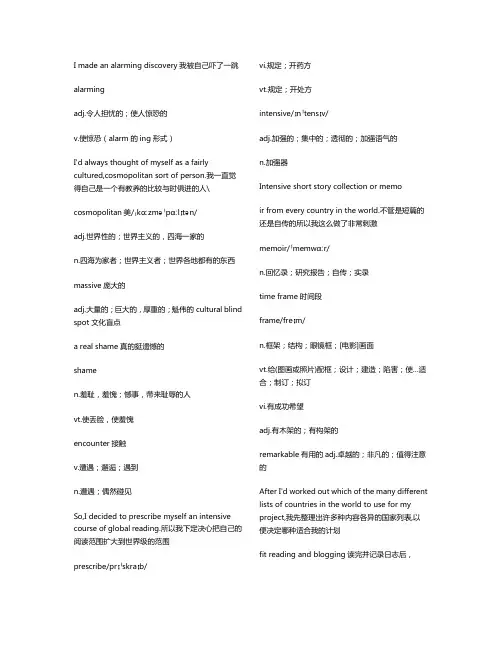
I made an alarming discovery我被自己吓了一跳alarmingadj.令人担忧的;使人惊恐的v.使惊恐(alarm的ing形式)I'd always thought of myself as a fairly cultured,cosmopolitan sort of person.我一直觉得自己是一个有教养的比较与时俱进的人\cosmopolitan美/ˌkɑːzməˈpɑːlɪtən/adj.世界性的;世界主义的,四海一家的n.四海为家者;世界主义者;世界各地都有的东西massive庞大的adj.大量的;巨大的,厚重的;魁伟的cultural blind spot文化盲点a real shame真的挺遗憾的shamen.羞耻,羞愧;憾事,带来耻辱的人vt.使丢脸,使羞愧encounter接触v.遭遇;邂逅;遇到n.遭遇;偶然碰见So,I decided to prescribe myself an intensive course of global reading.所以我下定决心把自己的阅读范围扩大到世界级的范围prescribe/prɪˈskraɪb/ vi.规定;开药方vt.规定;开处方intensive/ɪnˈtensɪv/adj.加强的;集中的;透彻的;加强语气的n.加强器Intensive short story collection or memoir from every country in the world.不管是短篇的还是自传的所以我这么做了非常刺激memoir/ˈmemwɑːr/n.回忆录;研究报告;自传;实录time frame时间段frame/freɪm/n.框架;结构;眼镜框;[电影]画面vt.给(图画或照片)配框;设计;建造;陷害;使…适合;制订;拟订vi.有成功希望adj.有木架的;有构架的remarkable有用的adj.卓越的;非凡的;值得注意的After I'd worked out which of the many different lists of countries in the world to use for my project,我先整理出许多种内容各异的国家列表,以便决定哪种适合我的计划fit reading and blogging读完并记录日志后,figures are similar for much of theEnglish-speaking world对于世界上讲英语的其他地区来说,这个数字也差不多proportion/prəˈpɔːrʃn/n.比例,占比;部分;面积;均衡vt.使成比例;使均衡;分摊primed to想准备好prime/praɪm/adj.主要的;最好的;基本的adv.极好地n.初期;青年;精华;全盛时期vt.使准备好;填装vi.作准备get a look-in有机会涉及到look-inn.迅速一瞥;顺道看望;成功的机会upshot n.结果,结局;要点invisible鲜为人知Exclusively/ɪkˈskluːsɪvli/adv.唯一地,专有地,排外地;作为唯一的(消息)来源Sourcing搜索Swaziland斯威士兰Namibia纳米比亚clueless literary xenophobe.外盲clueless/ˈkluːləs/adj.很愚蠢的;一无所知的,无能为力的(含贬义);无线索的xenophobe/'zɛnəfob/n.仇外;害怕生人者;畏惧和憎恨外国人的人narrow窄Detour/ˈdiːtʊr/n.迂回路;临时绕行道路v.绕道,绕行Panama Canal巴拿马运河tweet发布/twit/n.小鸟叫声;自录音再现装置发出的高音;推特vi.吱吱地叫;啾鸣get hold of把握;抓住;得到manuscripts/'mænjʊskrɪpts/n.[图情]手稿;草稿giving me privileged glimpses of some remarkable imaginary worlds.这让我有机会一窥某些精彩的世界and about marriage rituals in a remotevillage on the shores of the Caspian sea in Turkmenistan.他在19世纪领导反抗葡萄牙人我也读了土库曼斯坦的里海岸边glimpse/ɡlɪmps/n.一瞥,一看vi.瞥见vt.瞥见ritual/ˈrɪtʃuəl/n.仪式;惯例;礼制adj.仪式的;例行的;礼节性的Orgy/ˈɔːrdʒi/n.狂欢;放荡树上狂欢Angola/æŋˈɡoʊlə/n.安哥拉(非洲国家)quest求助/kwest/n.追求;寻找;任务(游戏术语)vi.追求;寻找vt.探索scratch/skrætʃ/n.擦伤;抓痕;刮擦声;乱写adj.打草稿用的;凑合的;碰巧的vt.抓;刮;挖出;乱涂vi.抓;搔;发刮擦声;勉强糊口;退出比赛dubious/ˈduːbiəs/adj.可疑的;暧昧的;无把握的;半信半疑的Portuguese/ˈpɔrtʃəˌgiz/adj.葡萄牙的;葡萄牙人的;葡萄牙语的n.葡萄牙人;葡萄牙语facilitate a joint creative endeavor团结起来创新努力的机会facilitat/fəˈsɪlɪteɪt/vt.促进;帮助;使容易mindset思想众/ˈmaɪndset/n.心态;倾向;习惯;精神状态enlighten更好认识/ɪnˈlaɪtn/vt.启发,启蒙;教导,开导;照耀Wrestling/ˈreslɪŋ/碰撞n.摔跤;扭斗v.摔跤;格斗(wrestle的ing形式);与…摔跤;使劲移动Little by little,that long list of countries that I'd started the year with,changed from a rather dry,academic register of place names into living,breathing entities.每翻一页便长一智积少成多我年初列出的国家列表从一些列枯燥充满学术的地名变成了活生生会呼吸的实体get a rounded picture of大致了解cumulatively积少成多/kjumjəletɪvli/adv.累积地;渐增地testament故事n.[法]遗嘱;圣约;确实的证明incentive动机/ɪnˈsentɪv/n.动机;刺激adj.激励的;刺激的。
2016.04G.E.R劳埃德(Geoffrey Ernest Richard Lloyd,1933~),英国剑桥大学教授,长期从事古希腊、古代中国科学思想史的研究工作。
其著述颇丰,到目前为止,已发表论文百余篇,专著二十余部。
劳埃德擅长使用比较历史学的研究方法,以新颖独特的视角去剖析问题。
其著作历史叙述条理清晰,史料翔实,反映了科学哲学与科学社会学的最新研究动态。
本文试图通过对他所提出的“宽容原则”、“研究风格”、“现象的多维度性”等概念进行简要分析,梳理其科学思想史研究中的跨文化观点,以期对科学思想史的近一步发展有所启示。
一、宽容原则在《古代世界的现代思考———透视希腊、中国的科学与文化》一书中,劳埃德提出了一个素来为许多只重视实证研究的历史学家所忽视的问题:理解古代社会如何可能。
他认为,在我们对古代世界的接近中,存在着双重障碍。
其一是史料的匮乏。
我们所能够获得的资料大多是以文字的形式被保存下来,反应的只是掌握读写能力的古代社会知识精英们对古代世界的看法。
奴隶对奴隶制的看法,童养媳对孩儿婚的观点,我们无从得知。
但比起对证据掌握的严重不足,他认为,第二重障碍———用来释读证据的概念框架所存在的问题更为严重。
这一问题致使我们在理解古代世界时陷入了一个进退两难的局面:一方面,如果我们利用自己所熟悉的现代概念工具去释读古代资料,存在着对古代社会进行曲解的风险。
“尤其在科学史中,这种曲解导致年代误植(anachronism)和目的论(teleolo-gy)”,即假设古人有目的地朝着现代的概念靠近。
而另一方面,如果我们强调使用真正古代语言的古代概念框架去理解古人,那么,这算不算是一种理解显然都成了问题,在某种程度上,它所做的只是对古代材料与概念的复述。
面对这一进退两难的局面,劳埃德提出了三种常见的反应:第一种反应假定“不同的智力状态(mentalities)是某种观念或行为的明显的难以理解的根源”,“明显荒谬的信仰仅仅反映了一种不同的心态(mind-set)。
《露丝.本尼迪克特 [浅析露丝本尼迪克特《文化模式》]》摘要:美国杰出人类学家露丝.本尼迪克特(18871948)的《文化模式》一书于20世纪30年代出版,该书阐发了一种新的文化研究理论文化模式论,本尼迪克特认为,整合的首要条件就是选择,不经选择,没有任何一种文化是可以被理解的,因而,文化整合也是文化自我完善的一种形式,既体现了文化在历时中的变迁,又使文化在共时中在一定限度内维持稳定秩序成为可能美国杰出人类学家露丝.本尼迪克特(18871948)的《文化模式》一书于20世纪30年代出版,该书阐发了一种新的文化研究理论文化模式论。
在本尼迪克特看来,文化,也即民族性,它在各个民族(部落、族群)的形成都有其自身的发展脉络和历史背景,它表现为一定的文化形态及行为。
她把所有潜在的人类意图、动机以及行为能力比作一个巨大的圆弧,所有可能的人类行为都分布在其上的这个大弧对于任何一个文化来说都太繁杂,太充满矛盾了,以致其中绝大部分是不能利用的,一个社会或部族面对无数人类行为的可能性,首要的就是选择。
每个人类社会都在其文化风俗中做出了自己的选择,这种选择具有自身文化独特的社会价值取向,选择的行为方式包括各种人生阶段的庆典仪式、宗教、婚姻、经济、政治等各领域的习俗, 经过代代流传,最终演化成为风俗、礼仪, 从而形成一个部落或部族的文化模式。
本尼迪克特的文化模式论的创造性贡献的一部分在于把心理分析概念引入对于文化的研究。
她的模式概念就是一个行动心理学的概念,不同于许多学者所说的类型。
文化类型是把已知的文化按事先规定的若干型加以归纳和分类;而文化模式则是规定文化特征的统一表现形态的特殊性和异质性,而非预先设定的类型分类。
她明确指出我们这里作为类型来讨论的这些完型,并不是说它们代表了一种固定的特性的群集分布。
世界上最不幸的事就是致力于把所有文化说成是一定数量的稳定的经过选择的形态的样品。
若形态对所有文明来说都是不可避免且适用的东西,那范畴就成为一种义务了。
The allure of Peking Opera, a traditional Chinese performing art form, has transcended cultural boundaries and captivated audiences worldwide. This ancient art form, with its rich history and unique characteristics, has become a symbol of Chinese culture. For those who have had the privilege of witnessing a performance, the experience is nothing short of mesmerizing.Growing up in a family where the appreciation for the arts was deeply rooted, I was introduced to Peking Opera at a young age. My grandparents, both avid fans, would often take me to the local opera house. The first time I stepped into the auditorium, I was struck by the vibrant colors, the elaborate costumes, and the melodious music that filled the air. It was an experience that would forever change my perception of art.Peking Opera, also known as Jingju, is a synthesis of various art forms including singing, dancing, acrobatics, and martial arts. It is a complex and intricate art that requires years of rigorous training and dedication. The performers, known as Peking Opera actors, are highly skilled in both the physical and vocal aspects of the performance. They are trained to master the four main types of roles: Sheng male roles, Dan female roles, Jing painted face roles, and Chou clown roles.One of the most fascinating aspects of Peking Opera is its use of facial makeup. Each characters makeup is carefully designed to reflect their personality, social status, and role in the story. The intricate patterns and bold colors serve as a visual representation of the characters inner world.For example, a red face typically signifies a loyal and brave character, while a white face might represent a treacherous and cunning individual.The music of Peking Opera is another element that sets it apart from other forms of theater. It is characterized by its highpitched, melodic tunes that are played using traditional Chinese instruments such as the erhu, pipa, and suona. The music is an integral part of the performance, providing a backdrop for the actors movements and enhancing the emotional depth of the story.The stories performed in Peking Opera are often based on historical events, legends, and folklore. They are a reflection of Chinese history and culture, providing a window into the past and offering valuable insights into the values and beliefs of the society. The narratives are rich in symbolism and metaphor, making them a source of inspiration and reflection for the audience.Despite its traditional roots, Peking Opera has evolved over time to adapt to the changing tastes and preferences of the audience. Modern productions often incorporate elements of contemporary theater, dance, and music, while still maintaining the core elements that define the art form. This fusion of old and new has helped to keep Peking Opera relevant and appealing to a wider audience.In recent years, there has been a growing interest in Peking Opera among international audiences. Many opera houses and cultural centers around the world have organized performances and workshops to introduce thisunique art form to a global audience. The success of these events is a testament to the universal appeal of Peking Opera and its ability to transcend cultural barriers.In conclusion, Peking Opera is a treasure trove of Chinese culture and history, offering a unique and captivating experience to those who are fortunate enough to witness it. Its intricate blend of music, dance, and storytelling, combined with the skill and dedication of its performers, make it a truly remarkable art form. As someone who has had the privilege of growing up in a family that appreciates the arts, I am grateful for the opportunity to have been introduced to Peking Opera and to have experienced its magic firsthand.。
海德格尔文艺观英语Hegel’s Aesthetics is a part of his philosophy of revelation which deals with the concept of beauty and art. In this school of thought, Hegel believed that each art form carries a certain kind of spiritual or cultural meaning. He argued that art has the power to reveal a certain truth or universality about humanity and its relationship with the divine. According to him, art should strive for a higherlevel of expression and communication. He viewed art as a dynamic process, in which creation and destruction were intertwined, and in which the true purpose of art was to represent the highest truth.In terms of his aesthetic views, Hegel looked at art from a symbolic perspective. He believed that artists must striveto create works of art that are ultimately reflective of a higher, spiritual reality. He believed that while an artist must be aware of the historical and cultural context in which a work is created, they must also strive to express something deeper and more meaningful. In this respect, Hegel arguedthat an artwork should strive towards universal harmony and beauty, wherein the message and meaning are made clear to all.In terms of literature and the literary arts, Hegel outlined a few principles. Firstly, he argued that literature should have the power to convey the ultimate truths of life. Secondly, he stressed the importance of artistic expression and the need for an artist to find a unique style or voicefor their works. Lastly, Hegel advocated for the use of metaphor, allegory and symbolism in writing to make the message more effective.Hegel's views on aesthetics were often seen as being far ahead of his time. He believed that art had a fundamental role to play in society, one which was instrumental in helping individuals to grapple with and comprehend the highest ideals of existence. His writings on aesthetics are still influential today, and are often cited as central to many modern schools of thought in the field.。
雷蒙德·弗思人文类型
雷蒙德·弗思(Raymond Williams)是一位英国文化理论家和
社会评论家,被广泛认为是20世纪最重要的人文学者之一。
他以其对文化、传媒、文学和社会变革的研究而闻名,并在
20世纪50年代至80年代期间对人文学科的发展产生了深远
影响。
弗思的人文类型主要集中于文化研究和意识形态分析。
他的研究聚焦于文化的生成、流行和变革,以及文化对个体和社会的影响。
他认为文化不仅仅是艺术和文学,而是一个广泛的概念,包括社会关系、价值观、想象力等多个方面。
他提出了"文化
的综合"概念,认为文化是社会过程中的一部分,与经济、政
治和社会结构密切相关。
弗思对传媒的研究也是他人文类型中的重要一部分。
他关注传媒对思想、价值观和意识形态的塑造作用,并指出传媒是一种文化生产的方式。
他对电视、广播、新闻和广告的分析揭示了传媒对社会认知和社会团结的影响。
从意识形态的角度来看,弗思的研究集中于权力和意识形态之间的关系。
他批评了一些思想家对于意识形态的狭隘定义,认为意识形态是一种对现实的理解和解释方式,可以通过语言、象征和符号来表达和传达。
综上所述,雷蒙德·弗思的人文类型主要包括文化研究、传媒
研究和意识形态分析。
他的研究深入探讨了文化对个体和社会的作用,并揭示了意识形态和权力之间的关系。
Annu.Rev.Psychol.2003.54:403–25doi:10.1146/annurev.psych.54.101601.145056Copyright c 2003by Annual Reviews.All rights reservedFirst published online as a Review in Advance on August6,2002 P ERSONALITY,C ULTURE,AND S UBJECTIVEW ELL-BEING:Emotional and Cognitive Evaluations of LifeEd Diener,1Shigehiro Oishi,2and Richard E.Lucas31Department of Psychology,University of Illinois,Champaign,Illinois61820;e-mail:ediener@2Department of Psychology,University of Minnesota,Minneapolis,Minnesota55455;e-mail:soishi@3Department of Psychology,Michigan State University,East Lansing,Michigan48824;e-mail:lucasri@Key Words quality of life,life satisfaction,positive affects Abstract Subjective well-being(SWB),people’s emotional and cognitive evalu-ations of their lives,includes what lay people call happiness,peace,fulfillment,and life satisfaction.Personality dispositions such as extraversion,neuroticism,and self-esteem can markedly influence levels of SWB.Although personality can explain a significant amount of the variability in SWB,life circumstances also influence long-term levels.Cultural variables explain differences in mean levels of SWB and appear to be due to objective factors such as wealth,to norms dictating appropriate feelings and how important SWB is considered to be,and to the relative approach versus avoidance ten-dencies of societies.Culture can also moderate which variables most influence SWB.Although it is challenging to assess SWB across societies,the measures have some degree of cross-cultural validity.Although nations can be evaluated by their levels of SWB,there are still many open questions in this area.CONTENTSINTRODUCTION (404)Defining Subjective Well-Being (404)History of Research on Subjective Well-Being (404)The Importance of Subjective Well-Being (405)Structure of the Review (406)PERSONALITY AND SUBJECTIVE WELL-BEING (406)Major Characteristics that Influence Subjective Well-Being (406)Personality Theories of Subjective Well-Being (408)Personality-Based Causes of Subjective Well-Being (409)CULTURE AND SUBJECTIVE WELL-BEING (410)Differences in Mean Levels of Subjective Well-BeingBetween Nations (410)0066-4308/03/0203-0403$14.00403404DIENER OISHI LUCASThe Causes of Societal Mean Level Differencesin Subjective Well-Being (410)Wealth and Related Predictors (410)Other Causes of Differences Between Cultures (411)Tradeoffs Between Subjective Well-Being and Other Values (412)Measurement Validity Across Cultures (413)Different Correlates of Subjective Well-Being Across Cultures (415)Universal Versus Variable Causes of Subjective Well-Being (417)Studying the Heterogeneity of Cultural Effects (418)EFFECT SIZES OF PERSONALITY AND CULTURE (419)CONCLUSIONS (419)INTRODUCTIONDefining Subjective Well-BeingThefield of subjective well-being(SWB)comprises the scientific analysis of how people evaluate their lives—both at the moment and for longer periods such as for the past year.These evaluations include people’s emotional reactions to events, their moods,and judgments they form about their life satisfaction,fulfillment,and satisfaction with domains such as marriage and work.Thus,SWB concerns the study of what lay people might call happiness or satisfaction.General reviews of SWB can be found in Argyle(2001),Diener(1984),Diener et al.(1999),and Kahneman et al.(1999).Everyone’s moods,emotions,and self-evaluative judgmentsfluctuate over time;SWB researchers study thesefluctuations but also examine the longer-term mean level differences that exist between individuals and societies.Although each of the components of SWB reflects people’s evaluations of what is happening in their lives,the facets of SWB such as positive affect,lack of negative affect,and life satisfaction show some degree of independence(Andrews&Withey1976,Lucas et al.1996)and therefore should be measured and studied individually.In many cases,however,researchers continue to measure a single aspect of well-being or ill-being such as depression or life satisfaction,and therefore those are the data that are available for this review.History of Research on Subjective Well-BeingSeveral different lines of research come together in the history of thefield of SWB.A major influence on thefield came from sociologists and quality of life researchers who conduct surveys to determine how demographic factors such as income and marriage influence SWB(e.g.,Bradburn1969,Andrews&Withey 1976,Campbell et al.1976).Another influence on thefield came from researchers working in the area of mental health,who wanted to extend the idea of mental health beyond the absence of symptoms of depression and distress to also include the presence of happinessSUBJECTIVE WELL-BEING405 and life satisfaction(e.g.,Jahoda1958).Yet another influence was from person-ality psychologists who studied the personalities of happy and unhappy people(e.g.,Wessman&Ricks1966).Finally,social and cognitive psychologists studiedhow adaptation and varying standards influence people’s feelings of well-being(e.g.,Brickman&Campbell1971,Parducci1995).These various strands werebrought together in integrative reviews by Diener(1984)and Veenhoven(1984).Because of the diverse influences on thefield,a variety of methods such as sur-veys,laboratory experiments,and intensive studies of individuals have all been commonplace.There are a number of theoretical traditions that have contributed to our un-derstanding of SWB.Humanistic psychology stimulated the interest in positive well-being.A number of factors such as temperament(Lykken&Tellegen1996), adaptation to conditions(Lucas et al.2002),and goal striving(Emmons1986) substantially influence levels of SWB.However,there is currently no single con-ceptual scheme that unites thefield,although attempts at unification have been made(e.g.,Diener&Lucas2000).SWB is measured in a variety of ways.For the emotional components,for exam-ple feelings of joy and contentment,broad survey measures have been used(e.g.,“In general how happy are you?”),as well as experience sampling of moods and emotions over time and informant reports from family and friends.The cognitive component of SWB has been assessed with life satisfaction surveys and also with measures of satisfaction and fulfillment in various life domains such as marriage, work,and leisure(see Sandvik et al.1993for a description of alternative methods of measurement of SWB).The Importance of Subjective Well-BeingSWB is one measure of the quality of life of an individual and of societies.Philoso-phers have debated the nature of the good life for millennia,and one conclusion that has emerged from this debate is that the good life is happy(although philoso-phers often differ on the definition of happiness).We consider positive SWB to be necessary for the good life and good society,but not sufficient for it.It is hard to imagine that a dissatisfied and depressed culture would be an ideal society,no matter how desirable it is in other respects.A person or society that has high SWB, however,might still be missing an ingredient such as fairness,which people might consider to be essential to a high quality of life.Diener&Suh(1998),working from the philosophical notion of utility,suggested that SWB is one of three major ways to assess the quality of life of societies,along with economic and social indicators.How people feel and think about their own lives is essential to under-standing well-being in any society that grants importance not just to the opinions of experts or leaders,but to all people in the society.We therefore maintain that abundant SWB is a necessary,but not sufficient,characteristic of the good society and the good life.As such,the area of SWB is of fundamental importance to the behavioral sciences.406DIENER OISHI LUCASStructure of the ReviewIn this chapter we focus on two interrelated factors that influence SWB—personality and culture.These two domains are intertwined in that both culture and personality are influenced by social learning,genetics,and their interactions,and both have significant influences on SWB.The parallels between culture and personality are obvious.Both can influence mean levels of SWB,as well as moderate the factors that correlate with people’s experiences of well-being.Furthermore,culture can influence personality,and vice-versa.Thus,both levels of analysis are fundamental to our understanding of SWB and are covered in this review.One aspect of the literature that we do not review concerns the outcomes of SWB—the benefits and costs of the experience of feeling good about one’s life.Lyubomirsky et al.(2001)reviewed evidence showing that happiness and high chronic levels of positive affect have benefits in terms of marital quality,income, creativity,sociability,and productivity.However,little is known about how either personality or culture moderates these outcomes.Most of the research has been conducted in western nations,and very little is known about how temperament might alter the benefits of high SWB.Therefore,we eagerly anticipate the time when sufficient empirical work will be available to allow an informative review of this domain.The challenge is to disentangle predictors and consequences of SWB;thus far this has been approached with long-term longitudinal designs and with experimental research in which emotions are manipulated and the results observed.PERSONALITY AND SUBJECTIVE WELL-BEINGMajor Characteristics that Influence Subjective Well-BeingEarly SWB researchers focused on identifying the external conditions that lead to satisfying lives.For example,in his influential article entitled“Correlates of Avowed Happiness,”Wilson(1967)catalogued the various demographic factors that were related to SWB measures.Yet after decades of research,psychologists came to realize that external factors often have only a modest impact on well-being reports(for a review see Diener et al.1999).Demographic factors such as health,income,educational background,and marital status account for only a small amount of the variance in well-being measures.Research instead shows that SWB is fairly stable over time,that it rebounds after major life events,and that it is often strongly correlated with stable personality traits.Thus,many researchers have turned their attention towards understanding the relations between personality and SWB.Although many personality traits have been linked with SWB(see DeNeve &Cooper1998for a review),much theoretical and empirical work has focused on the moderate to strong correlations between SWB and the traits of extraver-sion and neuroticism(Costa&McCrae1980,Tellegen1985,Headey&WearingSUBJECTIVE WELL-BEING407 1992,Watson&Clark1992).Lucas&Fujita(2000),for example,conducted a meta-analytic review and found that on average,extraversion correlated.38with pleasant affect at the zero-order level.Furthermore,when multiple,diverse meth-ods of measurement were used to model the association between extraversion and pleasant affect,the correlation often approached.80.Fujita(1991)found simi-larly strong correlations when he used structural equation modeling techniques to assess the strength of the correlation between neuroticism and negative affect. Because of the consistency of thesefindings,many researchers have suggested that extraversion and neuroticism provide the primary links between personality and SWB.Yet,as DeNeve&Cooper(1998)showed,focusing solely on extraversion and neuroticism may oversimplify the complicated pattern of associations among personality and SWB.There are a number of broad dimensions and narrower traits that have exhibited consistent correlations with SWB constructs.For example, DeNeve&Cooper showed that the Big Five dimensions of agreeableness and conscientiousness correlated approximately.20with SWB measures,and a number of narrow traits such as repressive defensiveness,trust,locus of control,desire for control,and hardiness all exhibited moderate correlations with SWB.It is clear that these and other traits such as self-esteem and dispositional optimism are related to SWB(Lucas et al.1996).What is unclear is whether these narrower traits uniquely predict SWB once the shared variance with traits such as extraversion and neuroticism is controlled.It is also likely that additional nontrait features of personality are related to SWB constructs.Emmons(1986)showed that various features of one’s goals (including the existence of important goals,progress towards those goals,and conflict among different goals)can have important implications for emotional and cognitive well-being;other researchers(e.g.,Cantor&Sanderson1999,Higgins et al.1999,Scheier&Carver1993)have suggested that the way we approach our goals influences SWB.In addition,researchers have suggested that having a coherent sense of one’s personality and acting in accordance with that personality are positively related to well-being(e.g.,Donahue et al.1993,Sheldon et al. 1997),though thesefindings might not generalize to less individualistic cultures (Suh1999).Whether researchers focus on traits or on other nontrait personality factors,they must be careful not to make inferences about causal priority from correlational data.Most studies of personality and well-being are correlational,and although researchers often assume that stable personality traits must influence what they believe to be the more transient feelings of well-being(e.g.,Eysenck&Eysenck 1985),there is evidence that the reverse causal direction may be true.For example, Cunningham(1988)and Isen(1987)have shown that inducing pleasant moods can lead to greater feelings of sociability,which is a defining characteristic of the extraversion trait.Thus,it is possible that chronically high levels of positive affect might induce greater sociability.Therefore,researchers must focus attention on determining the causal direction of the observed personality and SWB associations.408DIENER OISHI LUCASThis will require developing strong theories about the processes underlying the relations,as well as collecting longitudinal data.Personality Theories of Subjective Well-BeingIndividual differences in both personality and SWB emerge early in life,are stable over time,and have a moderate to strong genetic component(see Diener&Lucas 1999for a review).Thesefindings have led some to conclude that SWB is pri-marily determined by our inborn predispositions(e.g.,Lykken&Tellegen1996).Others have argued that the importance of inborn traits may depend on the types of questions we ask about SWB.For example,Lucas et al.(2002a)argued that by looking at SWB within individuals over time,researchers willfind that life events and life changes have important implications for well-being beyond the effects of personality.Yet,regardless of the origins of individual differences,personality and SWB researchers must develop precise theories that can explain why certain indi-viduals are chronically happier and more satisfied with their lives.Temperament theories of personality and SWB have been focused primarily on three aspects of individual differences in well-being:(a)baseline levels of affective and cogni-tive well-being,(b)emotional reactivity,and(c)cognitive processing of emotional information.For example,Headey&Wearing(1992)proposed the Dynamic Equi-librium Model,in which individuals have unique baseline levels of well-being that are determined by their personality.Specifically,they argued that individuals with certain personalities are likely to experience certain types of events—extraverts may be more likely than introverts to get married or to get a high-status job—and these events influence an individual’s average level of well-being.Unusual events can move a person above or below this baseline level,but according to Headey& Wearing,the individual will eventually return to baseline as events normalize.Other researchers have argued that average differences in well-being are due to differences in emotional reactivity.Based on Gray’s(1970,1991)theory of personality,scientists such as Tellegen(1985)and Larsen(e.g.,Larsen&Ketelaar 1989,1991;Rusting&Larsen1997)argued that extraverts are more reactive to pleasant emotional stimuli than are introverts,and neurotic individuals are more reactive to unpleasant emotional stimuli than are stable individuals.Although there has been some support for individual differences in reactivity in laboratory studies(e.g.,Larsen&Ketelaar1989,1991;Rusting&Larsen1997),evidence of real-world reactivity assessed in experience-sampling studies has been mixed(see e.g., Gable et al.2000,Lucas et al.2002b),and the small differences in reactivity that have been found do not account for all of the covariance between personality and SWB.Afinal temperament variable that might explain the relations between person-ality and SWB is the way people process emotional information.Rusting(1998) reviewed evidence that the personality traits of extraversion and neuroticism,as well as long-term affective traits and momentary affective states,are related to in-dividual differences in the processing of emotional content.There is evidence thatSUBJECTIVE WELL-BEING409 people are more likely to perceive,attend to,and remember emotionally congruent or trait-congruent information better than incongruent information.For example, Derryberry&Reed(1994)found that extraverts were slower than introverts to shift their attention away from rewarding stimuli.Tamir et al.(2002)found that extraverts more quickly related events to their motives when they were in a posi-tive mood,whereas introverts did so more quickly when they were in a negative or neutral mood.Diener&Lucas(1999)reviewed a number of additional theoretical explanations for individual differences in SWB,including emotion-socialization models and goal models.However,these models are often more useful in explaining the long-term stability and consistency of SWB than the specific links between personality traits and well-being.Personality-Based Causes of Subjective Well-BeingMost theories explaining the personality–well-being relation have focused on the direct effects of personality on emotional and cognitive well-being.However,it is also likely that there are indirect or interactional effects,such that different events and life circumstances affect well-being differently depending on one’s personal-ity.For example,although extraverts are generally happier than introverts,Kette (1991)found that extraverted prisoners were less happy than introverted prison-ers.This suggests that the situational features of prison were not congruent with an extraverted disposition.Oishi et al.(2001)illustrated the interaction between personality and situations more directly:They used a daily diary study to show that the experience of physical pleasure was more strongly related to daily sat-isfaction among high sensation-seekers than among low sensation-seekers.Other researchers have found,however,that extraverts do not react any differently than introverts to social and nonsocial situations and life circumstances(e.g.,Diener et al.1984,Lucas2001,Pavot et al.1990).Moscowitz&Cot´e(1995;also see Cot´e&Moscowitz2000)attempted to resolve the discrepantfindings by positing that it is not the congruence between personality and situations that is important for affect,but the congruence between personality and behaviors.They showed that experiencing trait-congruent or trait-incongruent situations was not related to differential levels of affect.For example, extraverts are not necessarily happier in social situations.However,for certain traits (agreeableness,dominance,and quarrelsomeness in one study;agreeableness and neuroticism in another),engaging in trait-congruent behaviors was associated with higher levels of positive affect,and trait-incongruent behaviors were associated with higher levels of negative affect.For example,dominant people are likely to report higher SWB when they are behaving in a dominant manner.Oishi et al.(1999b)suggested that values play an important interactive role in the associations between personality and well-being.They found that values moder-ated the relation between specific domain satisfactions and overall life satisfaction and values moderated the effect of daily activities on daily satisfaction.People high410DIENER OISHI LUCASin achievement orientation are more likely to take academic success into account than are low sensation seekers when evaluating their satisfaction with their day.To-gether,these studies suggest that it is necessary to examine units of analysis beyond simple traits and situations tofind interactive effects of personality on SWB. CULTURE AND SUBJECTIVE WELL-BEINGDifferences in Mean Levels of Subjective Well-BeingBetween NationsMany of thefindings on culture and SWB parallel the conclusions on personality and SWB.International surveys of life satisfaction show consistent mean level differences across nations(e.g.,Inglehart&Klingemann2000,Veenhoven1993).For instance,between the years1958and1987Japanese life satisfactionfluctuated around6on a10-point scale(Veenhoven1993).Denmark’s national average life satisfaction,on the other hand,fluctuated around a value of8.Cultural differences parallel to the international differences have been observed within the United States across different ethnic groups.For instance,Oishi(2001a)found that European Americans were significantly more satisfied with their lives than Asian Americans.Similarly,Okazaki(2000)observed that Asian Americans reported higher levels of depression and anxiety than did European Americans.Thus,there are differences between nations,and between ethnic groups within nations.The Causes of Societal Mean Level Differencesin Subjective Well-BeingMany studies are based on the analysis of nations rather than cultures per se because data are collected within each country.However,nations are often aligned with cultures because of their historical development,although obviously there is nota perfect match(e.g.,Hermans&Kempen1998).A comprehensive examinationof the effects of culture on well-being can be found in Diener&Suh(2000).A number of factors might explain why societies differ in mean levels of SWB(Diener&Lucas2000).In the following section we review several variables that appear promising in explaining nation-level differences.In our opinion societal differences in mean SWB are likely to be overdetermined—to be due to several factors,not to any single one.Wealth and Related PredictorsDiener et al.(1995)found large differences in SWB between nations,which cor-related substantially with the average levels of income in those nations.Diener& Biswas-Diener(2002)reviewed a number of studies that report correlations in the neighborhood of.60to.70between the wealth of nations and their mean levels of SWB.When we realize that wealthy nations are likely to score higher on human rights,equality,longevity,and democratic governance,the strong relation betweenSUBJECTIVE WELL-BEING411 wealth and SWB of societies is not surprising.Although attempts have been made to disentangle the effects on SWB of income and the various social indicators that co-occur in wealthier versus poorer nations,these have not been successful because of the high intercorrelation of the predictors and the limited sample size of nations available for such analyses.For example,Diener et al.(1995)concluded that individualism was crucial to the higher happiness levels of wealthy nations, but Schyns(1998)failed to replicate this pattern.Such attempts seem unlikely to achieve a replicable conclusion until we study a larger number of nations and have longitudinal measures of key variables.Income is most strongly related to SWB at very low levels of money,where small increments in wealth can have a substantial impact.For example,among re-spondents in the slums of Calcutta,Biswas-Diener&Diener(2001)report a strong correlation of.45between income and life satisfaction.Diener&Biswas-Diener (2002)report that the correlation between income and SWB is much smaller in eco-nomically developed nations.At the between-nation level,Inglehart&Klingemann (2000)report a curvilinear relation similar to that found for individuals(Diener et al.1993),in which income differences matter most to SWB at low levels of wealth.One explanation for why income matters most at low levels is based on the idea that at low levels of income,increases are likely to be related to inherent human needs,for example obtaining food and shelter,whereas at high levels of income,increases simply lead to the purchase of more luxury items(Veenhoven 1991).The hypothesis is that SWB results from meeting innate and universal hu-man needs and not from meeting desires that are not related to needs.In sum,the explanation for why higher SWB is reported in wealthy nations is unclear,but the finding itself has been replicated many times.Other Causes of Differences Between CulturesSocial psychological research in North America has demonstrated that self-serving bias occurs in various social judgments ranging from attributions(Zuckerman 1979)to reports of personality(Dunning et al.1989).Self-serving biases are deviations from reality that put the respondent in a more favorable light than is warranted by the facts.One self-serving bias is self-enhancement,which refers to rating oneself as relatively better compared to how one rates others.Such self-serving biases,however,occur less frequently among East Asians and are weaker when they do occur(e.g.,Heine et al.2000).In contrast,researchers have found self-critical tendencies in self-evaluations and attributions among East Asians(see Heine et al.1999).Thus,cultural difference in self-enhancement might be one factor causing cultural differences in mean levels of well-being.Oishi&Diener (2001c)found that European Americans overestimated the number of anagram tasks they solved a week earlier,whereas Asian Americans underestimated the number.In a daily diary study,Oishi(2001a)found that European Americans’life satisfaction judgment of the week as a whole was significantly higher than the average of their daily satisfaction during the same seven days,whereas Asian412DIENER OISHI LUCASAmericans’life satisfaction of the week as a whole was almost identical to the average of their daily satisfaction.In a related vein,recent research revealed cultural differences in approach versus avoidance orientation(Lee et al.2000,Briley&Wyer2002).For instance,Lee et al.(2000)demonstrated that thinking about one’s group membership,which is a chronic collectivist tendency,made people focus on negative consequences(i.e.,avoidance or loss focus),whereas thinking about one’s self independent ofothers,which is a chronic individualist tendency,made people focus on positive consequences(i.e.,approach or gain focus).In the context of SWB research,Elliot et al.(2001)found that Asian Americans,South Koreans,and Russians pursued more avoidance goals than did European Americans.In sum,cultural factors such as self-enhancement versus self-criticism and approach versus avoidance goals play a role in understanding mean differences in SWB across nations. Tradeoffs Between Subjective Well-Being and Other ValuesAn intriguingfinding emerging from thefield of SWB is that there are tradeoffs that seem inherent in certain societal patterns:cultural strategies that have both costs and benefits.For example,individualistic nations have high mean levels of reported SWB and at the same time also manifest the highest levels of suicide and divorce(Diener1996).It might be that the very same freedom arising from lowered social restraints on behavior can lead to happiness when things are going well,but can lead to higher levels of pathology such as suicide when things are going poorly.Marginal individuals such as those with mental illness or mental handicaps might have a harder time in individualistic societies than in collectivist ones,whereas people with a large number of strengths and resources might enjoy the individualistic lifestyle more.It is also possible that people who fail to achieve happiness in individualistic nations are more likely to commit suicide because they feel like failures and are less constrained by normative expectations.Another manifestation of tradeoffs is in thefinding that people are sometimes willing to sacrifice immediate happiness for the sake of achieving other goals that are valued in their culture.For example,Asakawa&Csikszentmihalyi(1998) found,using an experience-sampling method,that Asian-American students were more likely to be happy when they were engaging in an activity that was related to important future goals(e.g.,academic achievement),whereas Caucasian students were happy when engaging in an activity that was important to them at that moment.Interestingly,Caucasian students tended to be less happy when engaging in an activity that was related to important future goals.Oishi&Diener(2001c)also found that European Americans tended to switch to another task when they did not do one task well,whereas Asian Americans tended to stick with the task that they did not do well on,in order to master it(also see Heine et al.2001).The decision led to greater future enjoyment of the task of their choice among European Americans than among Asians.This strategy of switching activities when a person does not do well might be a good one in terms of maintaining positive moods.。